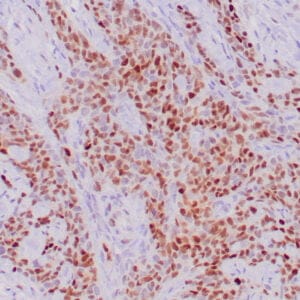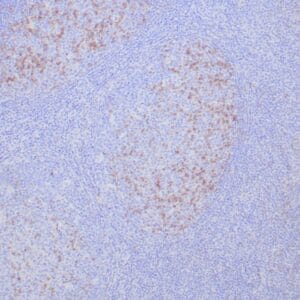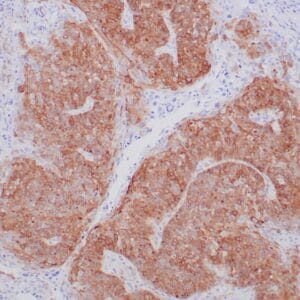| Weight | 1 lbs |
|---|---|
| Dimensions | 9 × 5 × 2 in |
| host | mouse |
| isotype | IgG |
| clonality | monoclonal |
| concentration | concentrate, predilute |
| applications | IHC |
| reactivity | human |
| available size | 0.1 mL, 0.5 mL, 1 mL concentrated, 7 mL prediluted |
rabbit anti-TROP2 monoclonal antibody (ZR388) 6393
Price range: $160.00 through $528.00
Antibody summary
- Rabbit monoclonal to TROP2
- Suitable for: Immunohistochemistry (formalin-fixed, paraffin-embedded tissues)
- Reacts with: Human
- Isotype:IgG
- Control: Colon or breast carcinoma
- Visualization: Cell surface
- 0.1, 0.5, 1.0 mL concentrated, 7 mL prediluted
rabbit anti-TROP2 monoclonal antibody ZR388 6393
| target relevance |
|---|
| Protein names Tumor-associated calcium signal transducer 2 (Cell surface glycoprotein Trop-2) (Membrane component chromosome 1 surface marker 1) (Pancreatic carcinoma marker protein GA733-1) |
| Gene names TACSTD2,TACSTD2 GA733-1 M1S1 TROP2 |
| Protein family EPCAM family |
| Mass 35709Da |
| Function FUNCTION: May function as a growth factor receptor. |
| Subellular location SUBCELLULAR LOCATION: Membrane; Single-pass type I membrane protein. |
| Tissues TISSUE SPECIFICITY: Placenta, pancreatic carcinoma cell lines. |
| Post-translational modification PTM: The N-terminus is blocked. |
| Involvement in disease DISEASE: Corneal dystrophy, gelatinous drop-like (GDLD) [MIM:204870]: A form of lattice corneal dystrophy, a class of inherited stromal amyloidoses characterized by pathognomonic branching lattice figures in the cornea. GDLD is an autosomal recessive disorder characterized by severe corneal amyloidosis leading to blindness. Clinical manifestations, which appear in the first decade of life, include blurred vision, photophobia, and foreign-body sensation. By the third decade, raised, yellowish-gray, gelatinous masses severely impair visual acuity. {ECO:0000269|PubMed:10192395}. Note=The disease is caused by variants affecting the gene represented in this entry. |
| Target Relevance information above includes information from UniProt accession: P09758 |
| The UniProt Consortium |
Data
 |
| Formalin-fixed, paraffin-embedded colon carcinoma stained with anti-TROP2 antibody using peroxidase-conjugate and DAB chromogen. Note the cell surface staining of tumor cells |
Publications
| pmid | title | authors | citation |
|---|---|---|---|
| We haven't added any publications to our database yet. | |||
Protocols
| relevant to this product |
|---|
| IHC |
Documents
| # | SDS | Certificate | |
|---|---|---|---|
| Please enter your product and batch number here to retrieve product datasheet, SDS, and QC information. | |||
Only logged in customers who have purchased this product may leave a review.















Reviews
There are no reviews yet.